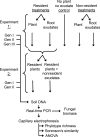Root exudates regulate soil fungal community composition and diversity
- PMID: 18083870
- PMCID: PMC2227741
- DOI: 10.1128/AEM.02188-07
Root exudates regulate soil fungal community composition and diversity
Abstract
Plants are in constant contact with a community of soil biota that contains fungi ranging from pathogenic to symbiotic. A few studies have demonstrated a critical role of chemical communication in establishing highly specialized relationships, but the general role for root exudates in structuring the soil fungal community is poorly described. This study demonstrates that two model plant species (Arabidopsis thaliana and Medicago truncatula) are able to maintain resident soil fungal populations but unable to maintain nonresident soil fungal populations. This is mediated largely through root exudates: the effects of adding in vitro-generated root exudates to the soil fungal community were qualitatively and quantitatively similar to the results observed for plants grown in those same soils. This effect is observed for total fungal biomass, phylotype diversity, and overall community similarity to the starting community. Nonresident plants and root exudates influenced the fungal community by both positively and negatively impacting the relative abundance of individual phylotypes. A net increase in fungal biomass was observed when nonresident root exudates were added to resident plant treatments, suggesting that increases in specific carbon substrates and/or signaling compounds support an increased soil fungal population load. This study establishes root exudates as a mechanism through which a plant is able to regulate soil fungal community composition.
Figures




Similar articles
-
Root biomass and exudates link plant diversity with soil bacterial and fungal biomass.Sci Rep. 2017 Apr 4;7:44641. doi: 10.1038/srep44641. Sci Rep. 2017. PMID: 28374800 Free PMC article.
-
The diversity of arbuscular mycorrhizal fungi amplified from grapevine roots (Vitis vinifera L.) in Oregon vineyards is seasonally stable and influenced by soil and vine age.Mycologia. 2009 Sep-Oct;101(5):599-611. doi: 10.3852/08-169. Mycologia. 2009. PMID: 19750939
-
Differential responses of soil bacteria, fungi and protists to root exudates and temperature.Microbiol Res. 2024 Sep;286:127829. doi: 10.1016/j.micres.2024.127829. Epub 2024 Jul 14. Microbiol Res. 2024. PMID: 39018940
-
Plant root exudation under drought: implications for ecosystem functioning.New Phytol. 2020 Mar;225(5):1899-1905. doi: 10.1111/nph.16223. Epub 2019 Oct 26. New Phytol. 2020. PMID: 31571220 Review.
-
Root exudates: from plant to rhizosphere and beyond.Plant Cell Rep. 2020 Jan;39(1):3-17. doi: 10.1007/s00299-019-02447-5. Epub 2019 Jul 25. Plant Cell Rep. 2020. PMID: 31346716 Review.
Cited by
-
The Sorghum bicolor Root Exudate Sorgoleone Shapes Bacterial Communities and Delays Network Formation.mSystems. 2021 Mar 16;6(2):e00749-20. doi: 10.1128/mSystems.00749-20. mSystems. 2021. PMID: 33727394 Free PMC article.
-
Microbial population and community dynamics on plant roots and their feedbacks on plant communities.Annu Rev Microbiol. 2012;66:265-83. doi: 10.1146/annurev-micro-092611-150107. Epub 2012 Jun 20. Annu Rev Microbiol. 2012. PMID: 22726216 Free PMC article. Review.
-
Peanut-based intercropping systems altered soil bacterial communities, potential functions, and crop yield.PeerJ. 2024 Feb 7;12:e16907. doi: 10.7717/peerj.16907. eCollection 2024. PeerJ. 2024. PMID: 38344295 Free PMC article.
-
Elucidating the significant roles of root exudates in organic pollutant biotransformation within the rhizosphere.Sci Rep. 2024 Jan 29;14(1):2359. doi: 10.1038/s41598-024-53027-x. Sci Rep. 2024. PMID: 38286879 Free PMC article.
-
Soil organic matter, rather than temperature, determines the structure and functioning of subarctic decomposer communities.Glob Chang Biol. 2022 Jun;28(12):3929-3943. doi: 10.1111/gcb.16158. Epub 2022 Mar 21. Glob Chang Biol. 2022. PMID: 35263490 Free PMC article.
References
-
- Akiyama, K., K.-I. Matsuzaki, and H. Hayashi. 2005. Plant sesquiterpenes induce hyphal branching in arbuscular mycorrhizal fungi. Nature 435:824. - PubMed
-
- Batten, K. M., K. M. Scow, K. F. Davies, and S. P. Harrison. 2006. Two invasive plants alter soil microbial community composition in serpentine grasslands. Biol. Invasions 8:217-230.
-
- Broeckling, C. D., I. R. Reddy, A. L. Duran, X. Zhao, and L. W. Sumner. 2006. MET-IDEA: data extraction tool for mass spectrometry-based metabolomics. Anal. Chem. 78:4334-4341. - PubMed
Publication types
MeSH terms
Substances
LinkOut - more resources
Full Text Sources
Other Literature Sources
Medical

